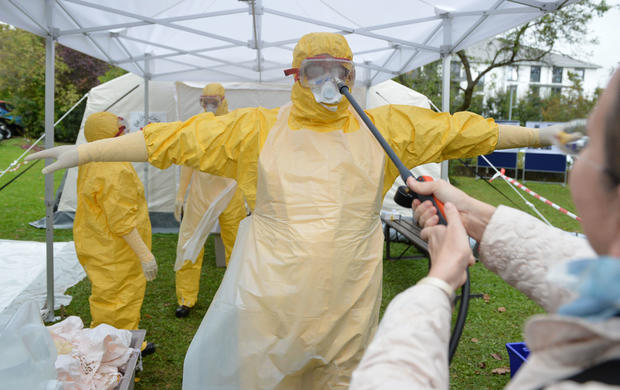Even with right protection, Ebola health care workers still at risk
In the battle against Ebola, health care workers continue to be among some of the most vulnerable to contracting the illness -- and several have gotten infected even when they seemed to be taking all the recommended precautions.
Doctors, nurses and other medical professionals have direct contact with highly contagious patients, though when they are armed with sufficient protective gear and follow safety protocols, the risk of transmission is greatly reduced. However, there have still been cases when those precautions may not have been enough.
Health officials in Spain -- and beyond -- are particularly alarmed by the case of a nurse's assistant in Madrid who was diagnosed with the Ebola virus Monday and is receiving treatment. She became infected while caring for a missionary priest who contracted Ebola while volunteering in Sierra Leone and who later died. This was the first case of transmission that has occurred outside of West Africa. The woman was believed to be complying with safety protocols and somehow got infected anyway.
Spain's health minister, Ana Mato, said they still are unsure how the nurse's assistant contracted the virus, and reported the woman had entered the patient's room only twice -- once to change the man's diaper and the second time to gather his belongings after he died. The corpse was still in the room at that time.
Another incident involving health care worker Nancy Writebol -- the American missionary who was infected while volunteering in Liberia -- is equally mysterious and concerning.
In an interview with Science Magazine, Writebol, who became ill in July and has since recovered, said she still doesn't know how exactly she was exposed to the virus. "I never felt like I was unsafe and I never felt like I walked into a situation where I was being exposed," she told Science Magazine. "I was on the low-risk side of things. I never was in the crisis or the Ebola center. I was always on the outside. I made sure doctors and nurses were dressed properly before they went in, and I decontaminated them before they went out. We kept a close check on each other about whether people felt safe."
Writebol said it's possible that a colleague who was doing the same job and died of Ebola may have infected her. The World Health Organization reports that 375 health care workers in West Africa have gotten sick and 211 have died, as of September 23.
Research has found that patients with acute Ebola infection have especially high viral loads, while corpses may be the most contagious of all.
Dr. Dalilah Restrepo, an infectious diseases specialist at Mount Sinai Roosevelt and Mount Sinai St. Luke's in New York City said regardless of how thorough training is, sometimes health care workers fail to follow through with protocols in moments of emergency with gravely ill patients. "It's hard to stick to the protocol 100 percent of the time when you're responding to emergencies; you get lax," Restrepo told CBS News. "We've seen in the removal process [of protective gear] there's always a risk for infection."
Restrepo does not know about the specifics systems in place at the hospital in Madrid where the nurse's assistant was infected, but she said the effective protocols for disease control include initiating a buddy system, in which someone trained in infectious disease control helps a doctor, nurse or other health care worker remove protective gear once they leave a patient's room. "It's pretty much from the ground up. Booties come off first," she said. "You want to remove as much as possible with your first layer of gloves."
Removal of gear from the top to bottom increases the risk for exposure because the eyes, nose and mouth are the first to be exposed and they are the primary means for transmission. Restrepo also said it's important to limit the number of people who have access to the rooms for sick patients.
Beyond that, some scientists now believe we may not know everything about this particular strain of the virus -- Ebola Zaire -- spreads from human to human. In an interview with the Los Angeles Times, Dr. C.J. Peters, who has conducted a number of important studies on Ebola transmission, said that unfortunately it may be too early to rule out the possibility that this particular strain of the virus has the capacity to spread through the air in tight quarters. "We just don't have the data to exclude it," said Peters, who currently researches viral diseases at the University of Texas in Galveston.
Public health officials have repeatedly stated that Ebola is not transmissible by simply breathing near a person who has it. However, it could spread if a patient's infectious bodily fluids come in contact with another person's broken skin or the mucous membranes of the eyes, nose or mouth.
